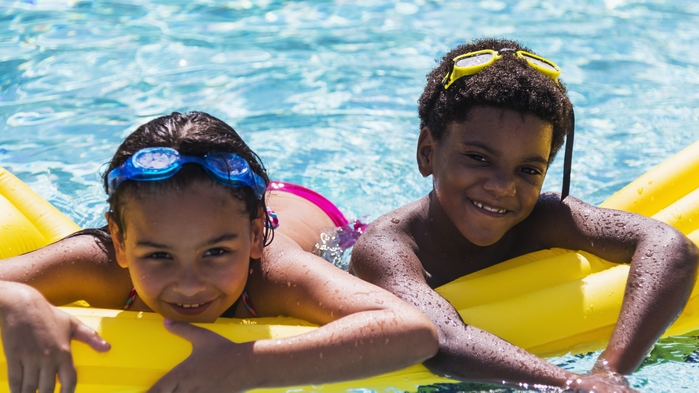By Hannah Six, Novant Health Healthy Headlines
To find and book a physician, click here.
Long summer days and balmy nights … this is the perfect time to indulge in the summer activities we love. But if we’re not careful, our favorite warm-weather pursuits can lead to injuries, many severe enough to require a trip to the emergency department.

“We see a real uptick in emergency room visits during the summer,” said Kelly Moriarty, injury prevention coordinator for Novant Health Trauma Services at Novant Health Presbyterian Medical Center in Charlotte. “That not only places an extra burden on ER staff — it also increases patient waiting times.”
To help you avoid painful injuries — and spending a single moment of summer in the ER — we asked Moriarty which activities put us at the highest risk when the weather heats up.
1. Overdoing it in hot weather
When temperatures soar, so does the risk of heat exhaustion and heat stroke, which may sound similar, but differ in their severity, Moriarty said.
“Heat exhaustion is often related to dehydration, which can lead to weakness and fatigue,” she said. “Other symptoms of this condition include sweating, nausea, clammy skin and an abnormal pulse rate.
“Heat exhaustion, unchecked, can become heat stroke, which is when the body is unable to control its core temperature,” she said. “Heat stroke is a life-threatening condition, so if someone shows signs, dial 911 immediately.”
Symptoms include a body temperature over 103 degrees, skin that’s red and hot to the touch, faintness or loss of consciousness, exhaustion, confusion and even hallucinations.
How you can prevent heat exhaustion and heat stroke:
Limit exposure to direct sunlight and try to stay cool. If you can’t remain in the shade, take frequent breaks from the sun. (Note: Sunscreen is important, but it doesn’t help prevent heat exhaustion or heat stroke.)
Avoid dehydrating alcoholic, caffeinated or sugary beverages. Stick with plain or electrolyte-fortified water.
Remember children and pets are also susceptible to heat. Never leave kids or pets alone in your car, which can heat to deadly temperatures in moments.
2. Taking on DIY and gardening projects
Working in the garden and taking on DIY jobs like building a new deck involve bending, stooping, carrying heavy objects and climbing ladders. You may end up with a gorgeous yard or jealousy-inducing deck, but the potential for back injuries and serious falls is real.
“Falling from a height or dropping heavy tools can cause fractures, sprains or head injuries,” Moriarty said. “We also see many injuries from lawn mowers — especially among children. So, it’s important to be vigilant.”
How to avoid DIY and gardening injuries:
Protect your body while tending your garden. Consider raised planters, and use cushions and stools to avoid joint and back strain.
Always have a helper on hand to steady the ladder and try to avoid distractions.
Keep children away from (and off of) lawn mowers. Ask them to remain indoors or in a different location, so they’re not tempted to approach the mower.
3. Setting off home fireworks
“The majority of firework injuries we see in the emergency department are from home fireworks, especially the small, handheld ones,” Moriarty said. “About half of these injuries involve people under 20 years old.”
If you do choose to set off fireworks at home, it’s important to keep them out of the reach of children and to follow all instructions to the letter. In the event of a burn, run the area under cool water and apply a sterile dressing, she said. Never apply ice, ointments or (that old home remedy) butter.
How to avoid injuries from home fireworks:
Never allow children to handle fireworks. This includes sparklers — essentially red-hot metal rods that can reach 2,000 degrees — which can cause serious burns and eye injuries.
Consider kid-friendly alternatives. Glow sticks, confetti poppers and bubbles make great substitutes.
4. Swimming and (mis)using trampolines
Entertainment, exercise and fun in the sun — these backyard favorites seem to offer it all. But unless they’re used with care, swimming pools and trampolines can pose real dangers.
“We often see head injuries, cuts and scrapes caused by running on slippery pool decks,” Moriarty said.
“And then there are the drownings and near drownings — which seldom happen like they do in movies. Instead of splashing, flailing and shouting, most drowning victims remain silent, so, it’s all too easy for a tragedy to occur even while others are nearby.”
The majority of trampoline injuries are fairly minor — sprained ankles or wrists — but people do show up at the ER with broken bones and head or neck injuries, Moriarty said. Many are caused by colliding with other jumpers, so it’s important to allow only one person at a time on the equipment, and always under adult supervision.
Tips on using swimming pools and trampolines safely:
Assign a designated “lifeguard.” At poolside parties where alcohol is being served, make sure at least one adult remains sober to supervise swimmers.
When in doubt, call 911. “Even if you can safely help them out of the water and they seem fine — it’s important to be sure they didn’t take any water into their lungs.”
Install safety equipment on your trampoline. Padding and a safety net can help prevent falls and injuries cause by the metal frame and springs.
5. Firing up the backyard grill
When you’re dealing with hot metal, flames and charcoal embers, a simple misstep can result in a serious burn. And, according to Moriarty, 35-40% of grill-related burns occur in children.
“Sometimes kids bump into the grill or knock it over,” she said. “So, establishing a safe-zone around the grill is helpful — making sure the only person within 3 feet of it is the one who’s cooking.”
Unless properly disposed of, the hot coals from charcoal grills can pose another hazard. She recommends soaking the embers with water and placing them in a designated container. Dumping them on the ground when children are playing outdoors can result in serious burns to bare feet. Also, if you close the vents on a kettle-style grill, remember the coals can stay hot for a period of time, even when the fire is “out.”
Novant Health
Healthy Headlines
Facebook
Instagram
Twitter
YouTube




